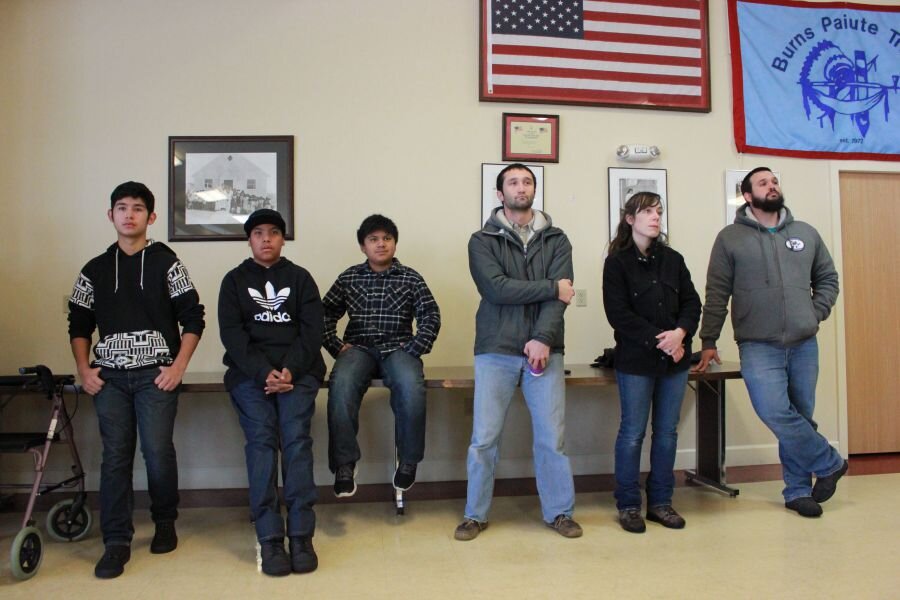The 'hostages' of Oregon standoff: 4,000 Paiute artifacts?
Loading...
As the armed occupation of an Oregon wildlife refuge enters its third week, with little public response from the government, many Americans' initial fascination with Ammon Bundy's eclectic group of protesters demands to return the land "to the people" has faded to weary frustration.
For the nearby Burns Paiute tribe, however, much more is at stake: 4,000 tribal artifacts, maps, and hundreds of sacred sites that they fear may be damaged or carted off for profit while their ancestral lands remain under the control of armed activists who see loggers and ranchers, not Native Americans or the federal government, as the land's rightful owners.
"As far as I'm concerned, our history is just another hostage," Paiute Tribal Council Chairwoman Charlotte Rodrique told the Associated Press.
After weeks of speaking out against the occupation, the tribe has written a letter to the US Fish and Wildlife Service (FWS), which manages the refuge, asking that the Citizens for Constitutional Freedom, as the occupiers are now calling themselves, be prosecuted for any damage to federally protected artifacts. A copy was also sent to the US Attorney for the state of Oregon, Billy Williams, according to the AP.
Ammon's brother, Ryan Bundy, said that occupiers were not interested in disrupting Native history. "If the Native Americans want those, then we'd be delighted to give them to them," he said. Asked if he thought that other looters could take advantage of the standoff, he told the AP, "We haven't really been thinking along those lines."
"It's a huge problem in Oregon, especially in the southeast portion of the state," Oregon State archaeologist Dennis Griffin told reporter Rebecca Boone. "More often than not, when they are caught, it's connected to drug running or seeking quick money on eBay."
Paiute artifacts kept at the refuge for research are protected by federal law, and some items, such as spears and baskets, are nearly 10,000 years old. Today, members of the tribe can gather grasses and seeds for traditional crafts and recipes, and access parts of the refuge for hunting and fishing.
In early January, occupation leader Ammon Bundy told reporters the Paiute tribe should be "freed from the government as well." Paiute leadership, however, says they prefer cooperation with the government to negotiating with the Constitutional Freedom group.
"Armed protesters don’t belong here," Chairwoman Roderique said Friday in a statement. "They continue to desecrate one of our most important sacred sites. They should be held accountable."
Carla Burnside, the FWS archaeologist at the Malheur refuge, holds the only key to the building's room where artifacts and maps to the park's other historical sites are kept. Videos and comments from the occupiers suggest that they may have seen them, but were not sure about their purpose.
But other valuable areas, including burial sites, could be damaged by the occupation's trucks and construction equipment, the tribe fears.
Despite the offer to return artifacts if the Paiute tribe reaches out to occupiers, the group has a very different view of the refuge's "owners" and history. Citizens for Constitutional Freedom have said they will not leave until the federal government returns the refuge to local, private ownership, which they say would benefit the region economically. Nearly 53 percent of Oregon is owned by federal agencies.
"We also recognize that the Native Americans had the claim to the land, but they lost that claim," Ryan Bundy told the AP. "There are things to learn from cultures of the past, but the current culture is the most important."
Federal agents have treated the standoff cautiously, wary of a violent confrontation. On Friday, they arrested protester Kenneth Medenbach, who had taken a stolen FWS vehicle to a Safeway grocery market.
"The government realizes this is a situation they can only lose if they take action. The only possible victory is to allow it to dissipate," UCLA law professor Adam Winkler told OregonLive.






